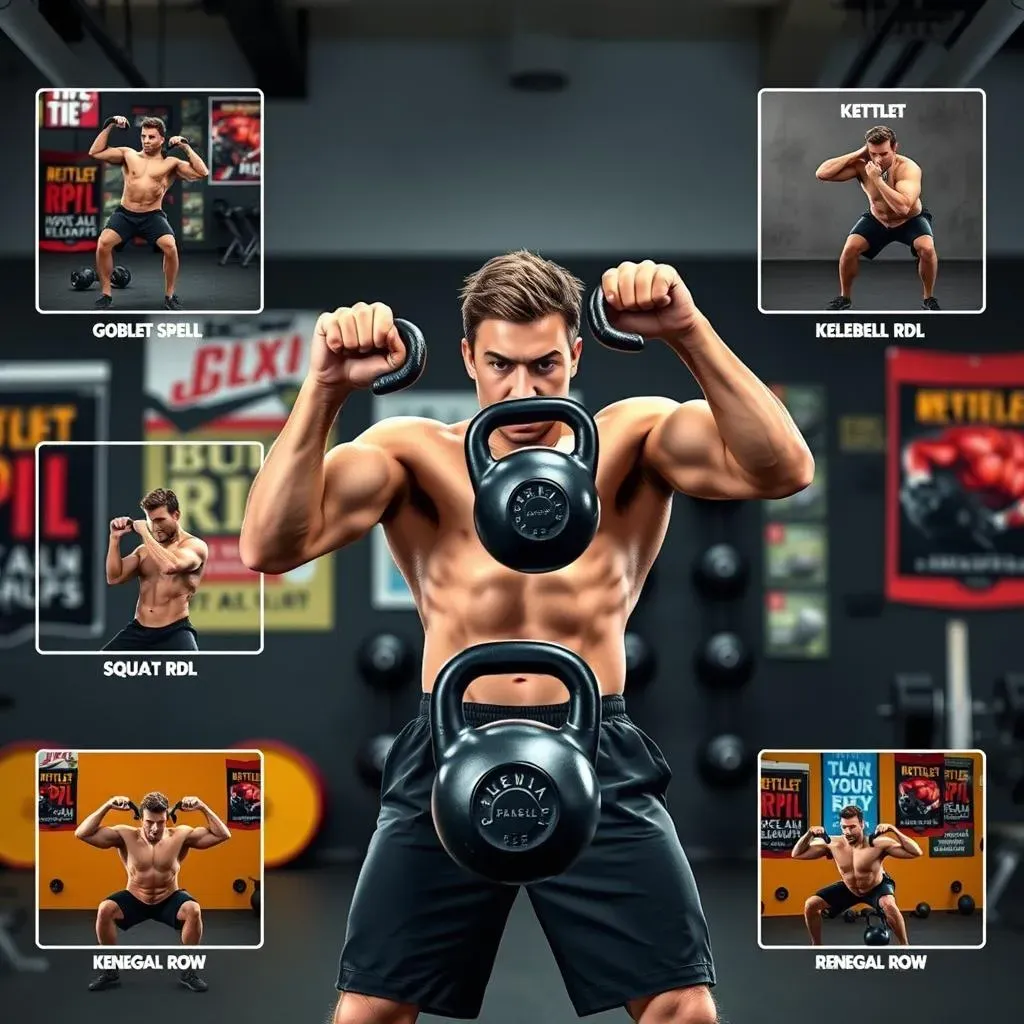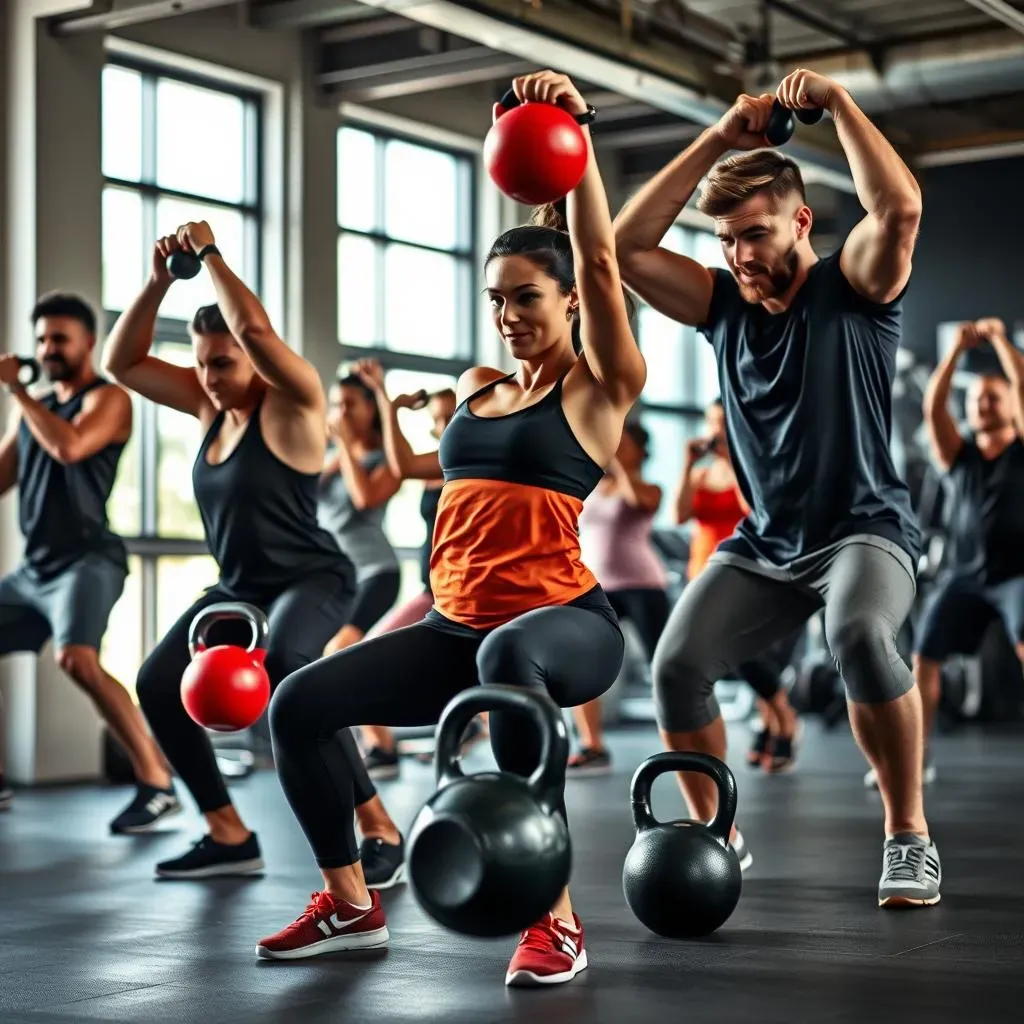Table of Contents
Ready to torch calories, build serious strength, and sculpt a lean physique? Look no further than full body workouts with kettlebells. These aren't your grandma's dumbbells; kettlebells offer a unique combination of strength training and cardio, engaging multiple muscle groups simultaneously. Forget spending hours on isolated exercises, kettlebells deliver a powerful, efficient workout that fits into even the busiest schedules.
Master the Kettlebell Swing: The Foundation of Full Body Kettlebell Workouts

Master the Kettlebell Swing: The Foundation of Full Body Kettlebell Workouts
Why the Kettlebell Swing is King
Seriously, if you're going to learn just one kettlebell exercise, make it the swing. The kettlebell swing isn't just an exercise; it's a movement pattern that teaches you how to properly hinge at the hips, engage your glutes and hamstrings, and generate power from your core. Forget about those endless crunches; the swing is a full-body powerhouse that blasts calories and builds functional strength.
Think of the swing as the ultimate bang-for-your-buck exercise. It hits your posterior chain (glutes, hamstrings, back) like a freight train, strengthens your core for improved stability and power, and even gets your heart rate soaring for a killer cardio workout. Plus, once you nail the technique, it feels incredibly satisfying. It’s like a primal movement that just feels…right.
Decoding the Kettlebell Swing Technique
let's break down the swing. It's not just about mindlessly flailing a weight around; it's about precision and control. Start with the kettlebell a few inches in front of you, feet shoulder-width apart. Hinge at your hips, keeping your back straight and your core engaged. Hike the kettlebell back between your legs like you're snapping a football. Then, explosively drive your hips forward, squeezing your glutes to propel the kettlebell up to chest height. Let the kettlebell swing back down between your legs, and repeat.
The key is to use your hips and glutes to generate the power, not your arms. Your arms should just be along for the ride. Keep your core tight throughout the movement to protect your lower back. And remember, it's a hinge, not a squat. Your knees should bend slightly, but the primary movement should come from your hips. Practice in front of a mirror or record yourself to check your form. Trust me, good form is essential to avoid injury and maximize the benefits.
Do | Don't |
|---|---|
Hinge at the hips | Squat down |
Keep your back straight | Round your back |
Engage your glutes | Use your arms |
Kettlebell Exercises for FullBody Fitness: Beyond the Swing

Kettlebell Exercises for FullBody Fitness: Beyond the Swing
Unlocking Full-Body Potential: More Than Just Swings
so you've mastered the kettlebell swing. Awesome! But don't stop there. The beauty of kettlebells lies in their versatility. They allow you to perform a wide range of exercises that target different muscle groups and movement patterns. Think of the swing as your foundation, and these other exercises as the building blocks to a complete, well-rounded full-body workout. We are about to expand your kettlebell arsenal.
Let's be real, doing only swings can get a bit monotonous. Variety is the spice of life, and it's also key to preventing plateaus and keeping your workouts engaging. By incorporating a diverse range of kettlebell exercises, you'll challenge your body in new ways, improve your overall fitness, and keep things interesting. Prepare to level up your fitness game!
Essential Kettlebell Moves for a Total Body Transformation
Ready to expand your repertoire? Here are a few must-try kettlebell exercises that will take your full-body fitness to the next level. First up, the Goblet Squat. Holding the kettlebell close to your chest, perform a deep squat, focusing on maintaining good form and engaging your quads and glutes. Then there’s the Kettlebell Romanian Deadlift (RDL). Hinge at your hips, lowering the kettlebell towards the ground while keeping your back straight. This is a fantastic exercise for strengthening your hamstrings and glutes.
Also, don't forget the Kettlebell Clean and Press. This is a dynamic, full-body movement that combines a clean (lifting the kettlebell from the ground to a racked position) with an overhead press. It's a great way to build strength and power in your shoulders, core, and legs. And finally, the Renegade Row. This exercise involves performing a row while in a plank position with each hand on a kettlebell. It’s a killer core strengthener and back builder. Master these moves, and you'll be well on your way to a complete kettlebell transformation.
Exercise | Target Muscles | Benefits |
|---|---|---|
Goblet Squat | Quads, Glutes, Core | Builds lower body strength, improves squat form |
Kettlebell RDL | Hamstrings, Glutes, Back | Strengthens posterior chain, improves hip hinge |
Clean and Press | Shoulders, Core, Legs | Builds full-body strength and power |
Renegade Row | Core, Back, Shoulders | Strengthens core, improves stability |
Crafting Your Kettlebell Full Body Workout Routine

Crafting Your Kettlebell Full Body Workout Routine
Designing Your Perfect Kettlebell Circuit
Alright, so you've got the moves down. Now it's time to piece them together into a killer workout. Crafting your kettlebell full body workout routine doesn't have to be complicated. Think of it like building a playlist of your favorite songs – you want a mix of exercises that flow well together and keep you motivated. Start by selecting 3-5 exercises that target different muscle groups. For example, you could pair swings with goblet squats, followed by clean and presses, and finish with renegade rows. The key is to create a balanced routine that hits all the major muscle groups.
Consider your fitness level and goals when choosing exercises and sets. If you're a beginner, start with lighter weights and fewer repetitions, focusing on mastering the form. As you get stronger, you can gradually increase the weight, reps, or sets. Remember, it's not about how much you can lift, but how well you can lift it. Proper form is always the priority. Also, don't be afraid to experiment and find what works best for you. Some people prefer circuit training, where you perform each exercise back-to-back with minimal rest. Others prefer traditional sets and reps with longer rest periods. There's no one-size-fits-all approach, so find what you enjoy and stick with it.
Sample Kettlebell Workout Routines
Need some inspiration? Here are a couple of sample kettlebell workout routines to get you started. Remember to adjust the weight, reps, and sets to match your fitness level. For a Beginner Routine, try 3 rounds of the following circuit: Kettlebell Swings (10 reps), Goblet Squats (8 reps), Kettlebell RDLs (8 reps), Plank (30 seconds). Rest for 60 seconds between rounds. If you are more of an advanced trainee, give this a shot: 4 rounds of the following circuit: Kettlebell Swings (15 reps), Clean and Press (8 reps per side), Renegade Rows (6 reps per side), Walking Lunges with Kettlebell (10 reps per leg). Rest for 45 seconds between rounds.
These are just examples, feel free to mix and match exercises to create your own custom routine. You can also adjust the number of rounds, reps, and rest periods to make the workout more or less challenging. Listen to your body and don't be afraid to modify the workout as needed. The most important thing is to be consistent and have fun! Kettlebell workouts can be a great way to get in shape, but they're even better when you enjoy them. Crank up the music, grab your kettlebell, and get ready to sweat!
Workout Type | Exercises | Rounds/Sets | Reps | Rest |
|---|---|---|---|---|
Beginner | Swings, Goblet Squats, RDLs, Plank | 3 Rounds | 10, 8, 8, 30 sec | 60 seconds |
Advanced | Swings, Clean & Press, Renegade Rows, Lunges | 4 Rounds | 15, 8, 6, 10 per leg | 45 seconds |
Full Body Kettlebell Workout: Form, Safety, and Progression

Full Body Kettlebell Workout: Form, Safety, and Progression
Nailing the Fundamentals: Prioritizing Form
Alright, let's talk shop about Full Body Kettlebell Workout: Form, Safety, and Progression. Look, I get it, you're pumped to start swinging and pressing, but before you go all-out, let's hammer down the importance of proper form. Bad form is like playing Russian roulette with your joints. Seriously, it's not worth the risk. Start slow, focus on mastering the movement patterns, and gradually increase the weight as you get stronger. Think quality over quantity, always.
Proper form isn't just about avoiding injuries; it's also about maximizing the effectiveness of the exercise. When you use the correct technique, you're engaging the right muscles and getting the most out of every rep. It's like the difference between strumming a guitar and actually playing a song. One is just noise, the other is music. So, take the time to learn the fundamentals, practice in front of a mirror, and don't be afraid to ask for help from a qualified trainer. Your body will thank you for it.
Staying Safe: Avoiding Common Kettlebell Pitfalls
Now that we've covered form, let's dive into safety. Kettlebells are awesome tools, but they can also be dangerous if you're not careful. One of the biggest mistakes people make is lifting too heavy, too soon. Ego lifting is a recipe for disaster. Start with a weight that you can comfortably control and gradually increase it as you get stronger. Also, always warm up before your workout and cool down afterward. Dynamic stretching and light cardio can help prepare your muscles for the workout and reduce the risk of injury.
Listen to your body! If you feel pain, stop the exercise immediately. Don't try to push through it. Pain is your body's way of telling you something is wrong. Also, be mindful of your surroundings. Make sure you have enough space to swing the kettlebell without hitting anything or anyone. And finally, don't be afraid to modify the exercises if needed. If you have any pre-existing injuries or limitations, talk to a doctor or physical therapist before starting a kettlebell workout. Safety first, always!
Safety Tip | Description |
|---|---|
Start with a light weight | Choose a weight you can control with good form. |
Warm-up and cool-down | Prepare your muscles and reduce injury risk. |
Listen to your body | Stop if you feel pain. |
Be mindful of your surroundings | Ensure enough space for safe movement. |
Maximizing Results: Diet and Recovery for Full Body Workouts with Kettlebells

Maximizing Results: Diet and Recovery for Full Body Workouts with Kettlebells
Alright, you're crushing those kettlebell workouts, feeling stronger, and looking leaner, that's awesome! But let's be real, you're not going to reach your full potential if you're neglecting your diet and recovery. It's like trying to build a house on a shaky foundation. Maximizing Results: Diet and Recovery for Full Body Workouts with Kettlebells is the secret sauce that will take your fitness to the next level. Think of your workouts as the spark, and your diet and recovery as the fuel that keeps the fire burning.
Fueling your body with the right nutrients is essential for muscle growth, energy levels, and overall performance. Focus on eating a balanced diet that's rich in protein, complex carbohydrates, and healthy fats. Protein is the building block of muscle, so aim to consume plenty of lean meats, poultry, fish, eggs, or plant-based protein sources. Complex carbohydrates provide sustained energy for your workouts, so load up on whole grains, fruits, and vegetables. Healthy fats are important for hormone production and overall health, so include sources like avocados, nuts, seeds, and olive oil in your diet. Hydration is also key, so drink plenty of water throughout the day, especially before, during, and after your workouts. Proper recovery is just as important as your workouts. When you exercise, you're actually breaking down your muscles. Recovery is the process of repairing and rebuilding those muscles, making them stronger and more resilient. Aim for at least 7-8 hours of sleep per night to allow your body to fully recover. Also, consider incorporating active recovery into your routine, such as light cardio or stretching, to help improve blood flow and reduce muscle soreness. And finally, don't underestimate the power of rest days. Taking a day or two off from exercise each week can help prevent overtraining and allow your body to fully recover.
Recovery Strategy | Description |
|---|---|
Sufficient Sleep | Aim for 7-8 hours of quality sleep per night. |
Active Recovery | Engage in light cardio or stretching on rest days. |
Rest Days | Take 1-2 days off from exercise each week. |
Proper Hydration | Drink plenty of water throughout the day. |
Full Body Workouts with Kettlebells: Your Path to a Stronger You
Incorporating full body workouts with kettlebells into your fitness routine is a game-changer. From mastering the fundamental swing to progressing through advanced exercises, the versatility of the kettlebell allows for continuous challenge and growth. Remember, consistency is key, and by prioritizing proper form, gradual progression, and listening to your body, you'll unlock a new level of strength, power, and overall fitness. So, keep swinging, keep pushing, and enjoy the journey to a healthier, stronger you with full body workouts with kettlebells!